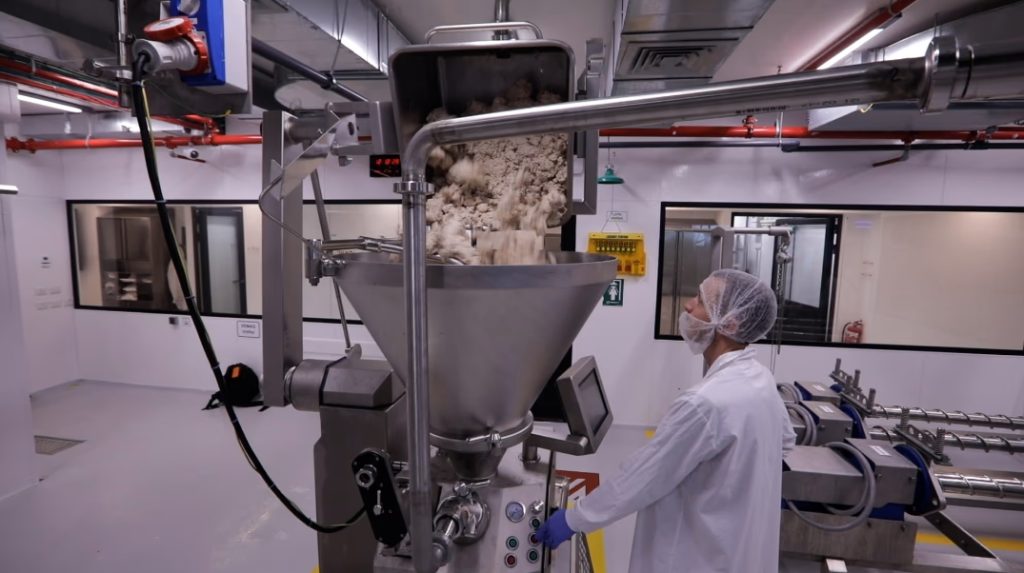The Believer Meats test kitchen was filled with a familiar aroma earlier this year as Research and Development Chef Andres Voloschin worked on flipping sizzling strips of chicken that were conjured from cells.
Through the glass walls, he could see the large tanks where the cells were growing. This sight was a testament to the innovative and groundbreaking work being done in the field of meat production.
It is no secret that the world’s meat consumption is on the rise, and with it comes a myriad of environmental and ethical concerns.
In response to this, more than 150 startups have emerged with an ambitious goal: to create meat that does not require the raising and killing of animals, while still being affordable and maintaining the taste and texture of traditional meat.
This young industry is harnessing the power of cell biology to address the ever-increasing demand for meat and to revolutionize global protein production.
Believer founder Yaakov Nahmias, whose country, Israel, is an industry hub along with California and Singapore, acknowledges the inherent human attachment to meat.
He states, “We are addicted to meat as a species. It’s part of our evolution. It’s part of our culture.” However, he also recognizes that the focus has historically been on quantity rather than the environmental and sustainability implications of meat production.
The companies involved in producing so-called “cultivated,” or “cultured” meat, which is also popularly known as “lab-grown” meat, are rapidly working to scale up their operations.
They are forming partnerships with traditional meat companies, attracting more investors, and breaking ground on new production facilities in the U.S. and other countries. This indicates a significant shift in the way meat is being produced and consumed.
The potential impact of this new approach to meat production is far-reaching. By reducing the reliance on traditional animal farming, cultivated meat has the potential to significantly decrease the environmental footprint of the meat industry.
This is particularly important in light of the growing concerns about climate change and the unsustainable nature of current meat production practices.
Furthermore, the development of lab-grown meat has the potential to address ethical concerns related to animal welfare.
By eliminating the need for raising and slaughtering animals for meat, this technology offers a more humane alternative that aligns with evolving societal values.
While the concept of lab-grown meat may be met with skepticism by some, it is important to recognize the potential benefits it offers.
The ability to produce meat in a more sustainable, ethical, and efficient manner has the potential to revolutionize the food industry.
As with any emerging technology, there will be challenges and obstacles to overcome, but the promise of a more sustainable and ethical approach to meat production makes this a development worth pursuing.
In conclusion, the emergence of lab-grown meat represents a significant step forward in addressing the environmental and ethical challenges associated with traditional meat production.
The industry is rapidly evolving, with numerous startups and companies working to bring this technology to scale.
As they continue to make progress, it is important to consider the potential benefits of this approach and to support the development of a more sustainable and ethical food industry.
The future of meat production may very well lie in the hands of these innovative and forward-thinking companies.

The wide adoption of meat from cells is facing numerous challenges that are hindering its progress. Despite the potential benefits of this innovative technology, there are several factors that are impeding its widespread acceptance and utilization.
One of the primary obstacles to the widespread adoption of cell-cultured meat is its high cost of production. The process of creating this type of meat is expensive, making it less accessible to the general population.
In addition, there are scientific challenges associated with mimicking the complex structure of traditional meat, particularly in replicating the texture and flavor of steak.
These challenges require extensive research and development efforts to overcome, further adding to the overall cost of production.
Furthermore, government regulation presents another significant barrier to the widespread adoption of cell-cultured meat.
Currently, only Singapore and the U.S. allow the sale of cultivated meat, limiting its availability in other markets.
The need for regulatory approval and compliance adds complexity to the commercialization of this technology, creating additional hurdles for companies seeking to bring cell-cultured meat to consumers.
In addition to economic and regulatory challenges, consumer acceptance of cell-cultured meat is a crucial factor in its widespread adoption.
While some individuals who have tried cell-cultured meat express positive feedback, there is a notable segment of the population that finds the concept distasteful.
A recent poll conducted by The Associated Press-NORC Center for Public Affairs Research revealed that half of adults in the U.S. would be unlikely to try cell-cultured meat, with many citing the unfamiliarity and perceived strangeness of the product as reasons for their reluctance.
Moreover, cultural and personal preferences play a significant role in shaping consumer attitudes towards cell-cultured meat.
For instance, the preference for traditional meat remains strong among many individuals, as evidenced by Nahmias’ 10-year-old son Oren, who expressed a reluctance to consume cell-cultured meat despite concerns for animal welfare.
This sentiment reflects the deeply ingrained cultural and culinary traditions associated with conventional meat consumption, which pose a challenge to the widespread acceptance of alternative meat products.
The scientific foundation of cell-cultured meat stems from the medical world, with bioengineers and researchers leveraging their expertise to develop innovative methods for producing meat from cells.
The process involves utilizing cells from various sources, such as tissue samples, fertilized eggs, or cell banks, and cultivating them in bioreactors to facilitate their growth and multiplication.
This approach represents a departure from traditional agriculture, as it eliminates the need for continuous reliance on animal sources for meat production.
Despite the promising advancements in cell-cultured meat technology, it is evident that the path to its wide adoption is fraught with challenges.
Addressing the cost of production, overcoming scientific hurdles, navigating regulatory requirements, and fostering consumer acceptance are critical aspects that require concerted efforts from industry stakeholders, policymakers, and the scientific community.
In conclusion, while the potential benefits of cell-cultured meat are compelling, its widespread adoption is far from assured.
Overcoming the multifaceted challenges associated with production, regulation, and consumer acceptance is essential for realizing the full potential of this innovative technology.
By addressing these challenges through collaborative efforts and continued innovation, the prospects for cell-cultured meat to become a viable and sustainable alternative to traditional meat can be significantly enhanced.
The emergence of cultivated meat represents a significant leap forward in the realm of food production and sustainability.
As companies like Believer and Aleph Farms venture into the realm of creating meat products through cellular agriculture, it is evident that the landscape of food production is undergoing a profound transformation.
However, despite the promising potential of cultivated meat, there exist a multitude of challenges that must be addressed before it can become a mainstream option for consumers.
The process of cultivating meat involves a sophisticated biotechnological approach that integrates cellular biology and food science.
At the heart of this process lies the extraction and manipulation of animal cells, which are then combined with plant proteins to create meat fibers.
This innovative approach, as envisioned by Believer and its competitors, not only offers a sustainable alternative to traditional livestock production but also holds the promise of significantly reducing the environmental impact associated with meat consumption.
The reduction in land use and greenhouse gas emissions, as well as the potential to address ethical concerns related to animal welfare, are all compelling reasons to pursue the development of cultivated meat.
Nevertheless, the journey toward making cultivated meat a viable and widely accepted option is riddled with obstacles.
One of the primary challenges lies in the complexity of creating genetically stable cell lines from larger animals, such as beef cattle.
The intricacies involved in maintaining genetic stability and ensuring the quality of the final product present formidable hurdles for companies like Believer and Aleph Farms.
Additionally, the texture and taste of cultivated meats, particularly those mimicking steak and other complex meat products, remain a point of contention.
The need to replicate the sensory experience associated with conventional meats, coupled with the imperative of achieving cost parity, is a crucial aspect that demands further attention and innovation.
The issue of cost is a significant barrier that must be overcome for cultivated meat to gain widespread consumer acceptance.
While the production costs have significantly decreased over time, as evidenced by the progress made by Mosa Meat, achieving price competitiveness with traditional meat products remains a formidable challenge.
The need for cultivated meats to not only match but surpass the taste and cost of conventional meats is a critical factor in determining their market viability.
As highlighted by industry experts such as Bruce Friedrich, the success of cultivated meats hinges on their ability to offer a comparable or superior experience at an equivalent or lower cost.
From a scientific standpoint, the development of cultivated meat also presents intricate technical dilemmas.

The selection of suitable scaffolds for structured meat, ensuring proper oxygenation of cells, and the sourcing of cell food are all areas that demand continued research and innovation.
The quest for sustainable and cost-effective alternatives to traditional cell culture media, such as fetal bovine serum, underscores the need for novel approaches to cellular agriculture.
While these scientific challenges are formidable, the collective expertise of researchers and innovators within the field instills confidence in the eventual resolution of these technical hurdles.
Beyond the scientific and economic considerations, the perception of cultivated meat among consumers represents a critical aspect that cannot be overlooked.
The prevailing association of meat production with traditional farms rather than scientific laboratories presents a significant psychological barrier.
The results of the AP-NORC poll, indicating a considerable degree of skepticism and apprehension among consumers, underscore the necessity of addressing public perception and education.
Overcoming the preconceived notions and concerns related to safety and authenticity will be pivotal in shaping the acceptance of cultivated meat in the mainstream market.
In conclusion, the advent of cultivated meat holds immense promise for revolutionizing the food industry and addressing the environmental challenges associated with traditional meat production.
The efforts of companies like Believer and Aleph Farms, alongside the relentless pursuit of scientific innovation, offer a glimpse into a future where sustainable and ethical alternatives to conventional meats become a reality.
However, the journey toward realizing this vision is fraught with challenges, ranging from technical and economic hurdles to the imperative of reshaping consumer perceptions.
As the field of cultivated meat continues to evolve, it is imperative for stakeholders to collaborate in addressing these challenges and paving the way for a future where sustainable, ethical, and delicious meat options are accessible to all.
